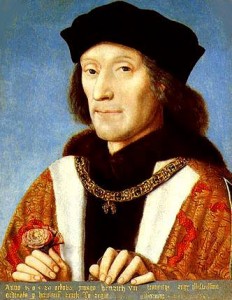 On this day in 1509, the body of Henry VII was taken from Richmond Palace to St Paul’s. Here’s an account by James Peller Malcolm (1767-1815) in Londinium redivivum:-
On this day in 1509, the body of Henry VII was taken from Richmond Palace to St Paul’s. Here’s an account by James Peller Malcolm (1767-1815) in Londinium redivivum:-
“On the 9th of May, 1509, the body of Henry VII. was placed in a chariot, covered with black cloth of gold, which was drawn by five spirited horses, whose trappings were of black velvet, adorned with quishions of gold. The effigies of his Majesty lay upon the corpse, dressed in his regal habiliments. The carriage had suspended on it banners of arms, titles, and pedigrees. A number of prelates preceded the body, who were followed by the deceased king’s servants; after it were nine mourners. Six hundred men bearing torches surrounded the chariot.
The chariot was met in St. George’s Fields [he died at Windsor] by all the priests and clergy of London and its neighbourhood; and at London Bridge by the Lord Mayor, aldermen, and common council, in black. To render this awful scene sublimely grand, the way was lined with children, who held burning tapers: those, with the flashes of great torches, whose red rays, darting in every direction upon glittering objects, and embroidered copes, showing the solemn pace, uplifted eyes, and mournful countenances, must have formed a noble picture. The slow, monotonous notes of the chaunt, mixed with the sonorous tones of the great bells, were not less grateful to the ear. When the body had arrived at St. Paul’s, which was superbly illuminated, it was taken from the chariot and carried to the choir, where it was placed beneath a hearse arrayed with all the accompaniments of death. A solemn mass and dirge were then sung, and a sermon preached by the Bishop of Rochester. It rested all night in the church. On the following day the procession recommenced in the same manner, except that Sir Edward Howard rode before, on a fine charger, clothed with drapery on which was the king’s arms.
We will now suppose him removed by six lords from his chariot to the hearse prepared for him, formed by nine pillars, set full of burning tapers, enclosed by a double railing; view him placed under it, and his effigies on a rich pall of gold; close to him the nine mourners; near them knights bearing banners of saints, and surrounded by officers of arms. The prelates, abbot, prior, and convent, and priests, in measured paces, silently taking their places; when, breaking through the awful pause, Garter King-at-Arms cried, with an audible voice, ‘Pray for the soul of the noble prince, Henry the Seventh, late king of this realm.’ A deep peal from the organ and choir answers in a chaunt of placebo and the dirge; the sounds die away, and with them the whole assembly retires.”
Henry VII was buried at Westminster Abbey on 11 May 1509. He shares a vault with his wife, Elizabeth of York, beneath a beautiful tomb topped with gilt bronze effigies of the couple in the Lady Chapel.
(Taken from On This Day in Tudor History by Claire Ridgway.)